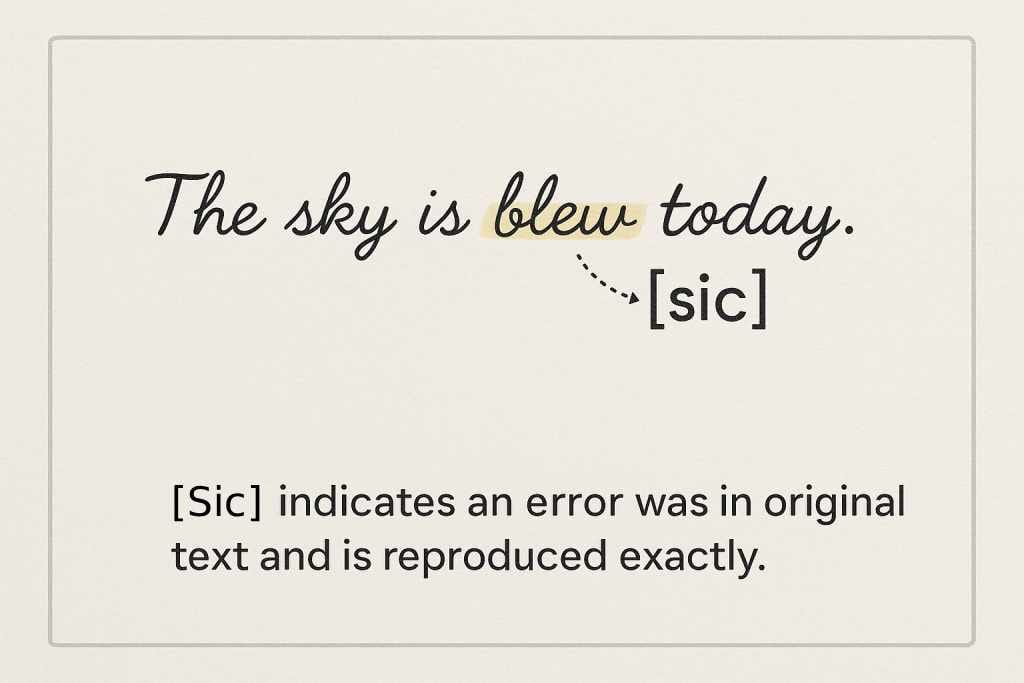In both literary and journalistic contexts, the small but pointed word sic serves a highly specific purpose. It signals to the reader that an error, unusual spelling, or odd phrasing has been preserved exactly as it appeared in the source material. This bracketed marker—often seen as [sic]—is one of those editorial tools whose meaning is widely guessed at yet rarely explained in full. Understanding its function is essential for anyone who works with quotations, transcriptions, or archival texts.
What is sic?
The term sic comes from the Latin adverb meaning “thus” or “so.” In writing, it tells the reader that the words preceding it have been reproduced exactly as in the original source. This means that any misspellings, grammatical mistakes, or unconventional usages are not the fault of the person quoting the material but are an accurate reflection of the original.
For example:
The streets are filled with peaple [sic] waiting for the parade.
Here, sic assures the audience that the misspelling of “people” was present in the original text.
What does sic stand for?
While sic is not an acronym, its placement within square brackets has given it an aura of formality that sometimes leads people to think it must “stand for” something. In reality, it is simply a Latin term meaning “so” or “thus,” signaling “this is exactly how it appeared.”
In full, it can be read as sic erat scriptum—Latin for “thus it was written.” This expanded form makes its intent even clearer: the quoted material is untouched.
What does sic mean in writing?
In modern usage, sic appears most often in academic, legal, historical, and journalistic writing, where accurate transcription is critical. It functions as a neutral indicator, though it can sometimes carry an implicit judgment about the quality or correctness of the original. Its significance lies in how it protects the integrity of both the source and the person quoting it.
Common Functions
- Preserving authenticity – Maintaining the original form of a quote without silent corrections.
- Clarifying responsibility – Ensuring any error is understood to be in the original text, not added by the quoter.
- Providing transparency – Letting the audience see the exact language used, even when flawed.
How to Use Sic Correctly
Placing [sic] requires care. Overuse can distract from the text, while omission may leave the reader questioning accuracy. It is usually placed immediately after the questionable word or phrase, within the quotation marks.
Correct usage:
She said, “I am absolutly [sic] certain this is the right address.”
Incorrect usage:
She said, “I am absolutly certain this is the right address.” [sic]
(This placement suggests the whole sentence is suspect, rather than just the misspelled word.)
Best Practices
- Use sparingly; avoid littering the page with [sic] unless necessary for accuracy.
- If multiple errors occur, consider a brief editorial note instead of repeated insertions.
- Retain the original formatting, capitalization, and punctuation when marking sic.
Literary and Historical Examples of Sic
The marker is not limited to modern reportage; it appears in scholarly editions of classic literature, historical letters, and archival transcriptions.
- In literary editing – When preserving authorial quirks or idiosyncrasies. For instance, in a scholarly edition of Emily Dickinson’s letters, unusual capitalization might be retained with a [sic] to confirm that it was original.
- In historical documents – Archival transcriptions of speeches or handwritten records often contain archaic spellings. Editors may insert [sic] to indicate fidelity to the source.
- In journalism – When quoting directly from social media posts, emails, or public statements that contain typos or unconventional grammar.
Below are three examples from literature where editors or authors used [sic] to preserve an original error:
- Jane Austen (Letter to her sister Cassandra, 29 May 1811): “Our young piony [sic] at the foot of the Fir tree has just blown & looks very handsome…” – Here the editor keeps Austen’s original misspelling of “peony” as “piony,” marking it with [sic] to show the mistake came from Austen’s letter, not the modern transcriber.
- Emily Dickinson (Letter to Samuel Bowles, 1859): Describing her delicate life, Dickinson wrote, “lest one stumble opon [sic] one’s hopes in a pile of broken crockery.” The [sic] after “opon” signals that she originally spelled “upon” incorrectly, and the published edition reproduces the error exactly as written.
- Cole Porter (personal correspondence, 15 July 1953): In a letter, Porter gave instructions about phonograph records: “Each of these records should have an adaptor placed in it’s [sic] center before sending.” The editor inserts [sic] to preserve Porter’s grammatical mistake – using “it’s” (with an apostrophe) instead of the correct “its” – thereby faithfully recording his original wording.
Sic in Academic and Legal Writing
In legal documents and academic papers, sic has an additional role: it safeguards against any suggestion that the quoter has misrepresented a source. Because these fields often rely on verbatim citations, even minor deviations can lead to challenges to credibility. The presence of sic preemptively addresses such concerns.
Example in legal citation:
The contract was “signed on the twelvth [sic] of May.”
Such usage shows that the transcription is faithful, even when the original contains an error.
Tone and Perception
Though sic is formally neutral, its inclusion can be read as subtly critical, especially in journalism or polemical writing. A misspelling or malapropism followed by [sic] draws attention to the slip. Skilled editors weigh the need for accuracy against the risk of distracting or embarrassing the source unnecessarily.
Further Reading
How to use [Sic] by Merriam-Webster
The pedantic, censorious quality of “sic” by Sentence first, stancarey.wordpress.com
The (sic.) on Page 11 of Infinite Jest on Reddit




